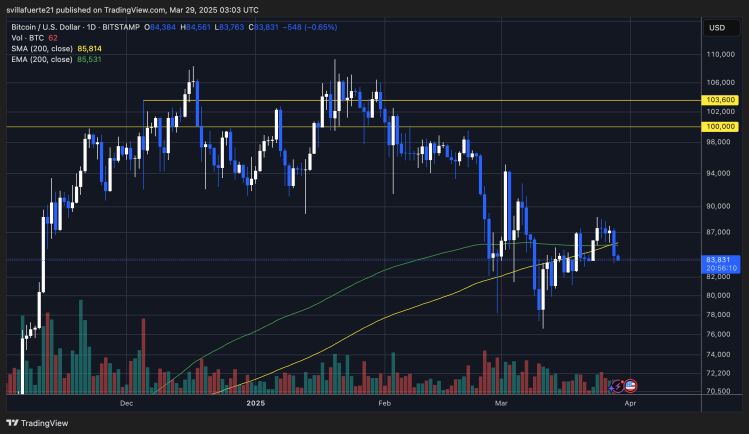//Bitcoin Defies Market Turmoil as It Outperforms Stock Market Decline//
Bitcoin is currently navigating turbulent market conditions, trading below a crucial demand zone as bearish sentiment regains control. This downturn has erased the brief optimism seen earlier, with selling pressure intensifying. Despite these challenges, Bitcoin has displayed resilience compared to traditional financial markets, which are struggling under macroeconomic uncertainties.

According to insights from Santiment, the S&P 500 and global stock markets have faced steep declines due to ongoing trade tensions and inflation fears. The S&P 500 fell sharply to $5,580, marking its lowest level since mid-March. In contrast, Bitcoin managed a modest gain of +0.4% and was valued at approximately $84,300 at the time of writing.
A key observation is Bitcoin’s mild rebound on the 4-hour chart following the stock market’s weekly close. This suggests that Bitcoin may be beginning to decouple from traditional equities, a trend that could indicate growing confidence in its long-term potential as a store of value. Historically, Bitcoin has closely mirrored stock market movements, but this correlation appears to be weakening.
Bitcoin’s Strength Amid Market Uncertainty
Bitcoin’s recent price movement reflects an ongoing struggle between bulls and bears. While bulls have failed to reclaim key resistance levels, Bitcoin has demonstrated relative stability compared to other risk assets. With the broader financial markets facing continued pressure from economic instability, Bitcoin’s resilience stands out.

At present, BTC is holding a market value of around $84,300, while the S&P 500 has suffered a considerable drop. This divergence hints at a potential shift in investor sentiment, with digital assets possibly gaining favor over traditional markets during uncertain economic times.
Bitcoin’s Correlation with Traditional Assets
Historically, Bitcoin has shown strong correlations with both the S&P 500 and gold. However, its recent price action indicates a potential break from this pattern. The cryptocurrency’s ability to remain relatively stable while equities decline suggests that investors may be viewing it as a hedge against traditional market volatility.

One of the strongest signs of Bitcoin’s subtle strength is its mild rebound in the wake of stock market declines. This decoupling, though still in its early stages, could signal a broader trend of investors seeking alternatives beyond traditional financial instruments. If Bitcoin can maintain this trend, it may emerge as a more independent asset class over time.
Key Price Levels to Watch
Bitcoin is currently consolidating around $83,800 after failing to break through the critical $90,000 resistance level. While it has managed to hold above short-term support, bullish momentum remains weak. The longer Bitcoin stays below $85,500—the 200-day moving average (MA)—the greater the risk of further declines.
Reclaiming the 200-day MA is crucial for Bitcoin’s recovery. If BTC can climb above this level, it could trigger a rally toward the $89K–$91K resistance zone. Conversely, failing to hold the $82,000 support level could lead to a significant decline, potentially pushing Bitcoin below $80,000.
Market Outlook
As macroeconomic pressures persist, Bitcoin’s next moves will be critical. The ongoing trade tensions and inflation fears continue to weigh heavily on global financial markets. If Bitcoin can maintain its relative strength, it may attract more institutional interest as a long-term investment option.
Bulls must act swiftly to reclaim key technical levels to confirm a recovery trend. Otherwise, continued bearish pressure could lead to further downside, testing Bitcoin’s resilience in the face of broader economic uncertainty. Regardless of short-term price fluctuations, Bitcoin’s ability to diverge from traditional markets may strengthen its case as a viable alternative asset in the long run.
.jpg)


Comments